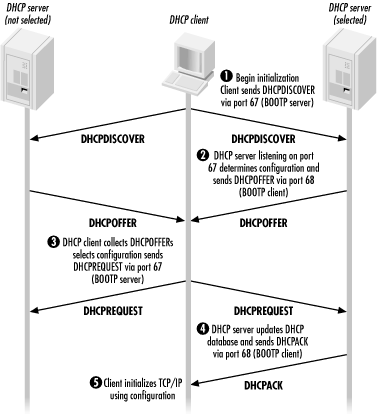The DHCP Conversation
There are three main components in a DHCP conversation, as shown in Figure 3.2.
The first component, the DHCP client, is the software portion of an operating system that is designed to request IP addresses and other related configuration information. Once it receives the requested information, the software reconfigures the operating system.
The second component, the DHCP server, is a program that listens for requests from DHCP clients on the network and supplies them with the information that is requested. The DHCP server is maintained by a network administrator. It is configured with a database that houses the configuration information, including IP addresses, subnet masks, default gateways, and DNS and WINS server addresses. The database also tracks which IP addresses are currently in use and which MAC addresses are using them.
The third component is the DHCP relay agent. Identical to the BOOTP relay agent, the DHCP relay agent listens for DHCP broadcasts on its local subnets. The DHCP relay agent is configured with IP addresses of DHCP servers. If it receives a DHCP broadcast from a DHCP client, the DHCP relay agent will send the request as a unicast message directly to a DHCP server. I will examine BOOTP and DHCP relay agents later in this chapter.

Figure 3-2. The DHCP conversation
DHCP greatly differs from BOOTP in how it handles the conversation between ...
Get DHCP for Windows 2000 now with the O’Reilly learning platform.
O’Reilly members experience books, live events, courses curated by job role, and more from O’Reilly and nearly 200 top publishers.

